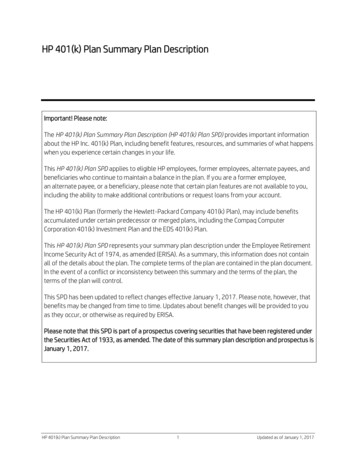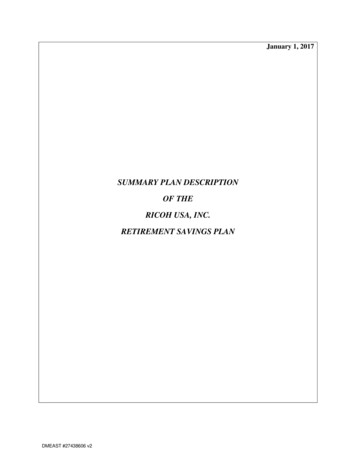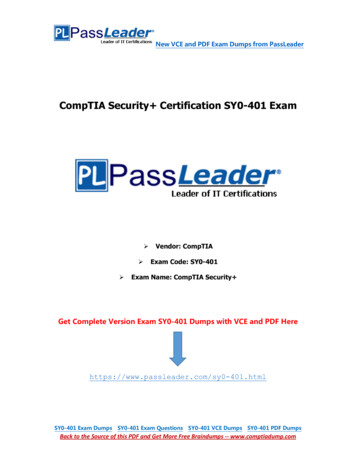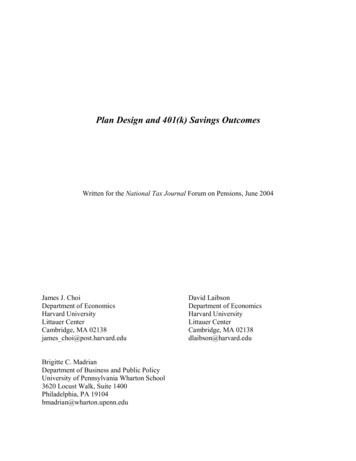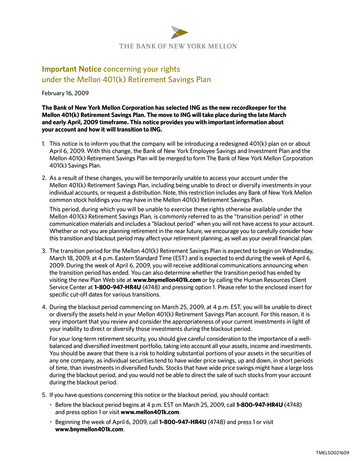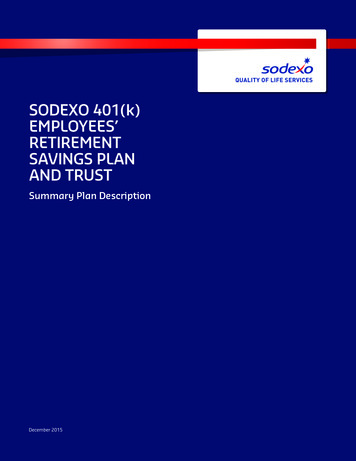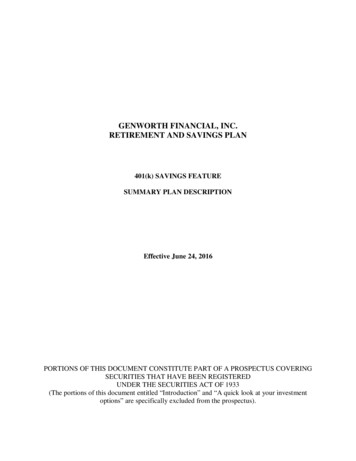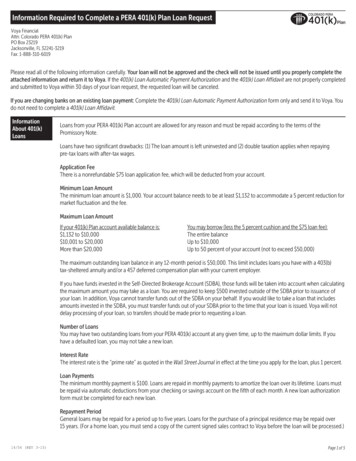
Transcription
401(k)Savings PlanSummary Plan Description2016
401(k) Savings Plan Table of ContentsSummary Plan DescriptionPageEligibility and Participation in the Plan.2 Tier 2 Eligibility.2Contributions.2 Employer Non-Elective or Matching Contributions.3 Employee Elective Deferrals.3 Tier 2 Employer Required Contributions.3Vesting.4Future Investment Allocation.4 Contribution and Deferral Limits.4 Catch-Up Contributions.5Rollovers and Transfers into the 401(k) Plan.6 PLSO Rollovers.7Investment Options.7 Individual Investment Options.7 Target Date Funds.8 Default Investment Option.9 Self-Directed Brokerage Account. 10 Transfer Policies. 11 Core Fund Dividends and Interest. 12 Managing Your Account. 12 Fund Information and Calculators. 13Withdrawing Funds from Your Account. 13 Retirement or Separation from Service. 14 Disability. 14 Financial Hardship. 14 Attainment of Age 59½. 15 Death. 16 Spouse as Beneficiary. 16 Tier 2 Defined Contribution PlanActive Employee Death Benefit. 16 Tier 2 Defined Contribution PlanAccelerated Death Benefit. 17 Domestic Relations Order (DRO). 17 Qualified Reservist Distribution. 17 Required Minimum Distribution (RMD). 17 Involuntary Distributions of Inactive Accounts. 18 Plan-to-Plan Transfers. 18 Taxes. 19401(k) Loans to Participants. 20 Eligibility. 20 Minimum Loan. 20 Maximum Loan. 20 Loan Repayment. 20 Automated Clearing House (ACH). 21 URS Check Policy. 21 Interest Rate on Loans. 21 Loan Fee. 22, 24 Taxes and Penalties. 22 Application of Funds. 22Plan Fees and Expenses. 22 Investment and Administrative. 23 Inactive Account Maintenance. 24 Short-Term Trading. 24 Self-Directed Brokerage Account. 25Welcome to theUtah Retirement Systems401(k) PlanThe Utah Retirement Systems (URS) 401(k) Planis a qualified tax-deferred plan governed bySection 401(k) of the Internal Revenue Code, andauthorized under Title 49 of the Utah Code.This Summary Plan Description is intended toprovide a brief description of the current provisionsof the URS 401(k) Plan and is not intended to serveas a complete or final description of this plan.For additional information about this plan andinvestment options, please visit www.urs.orgor call our Defined Contribution Departmentat 801-366-7720 or 800-688-401k.Planning and saving for retirementisn’t always easy, but it isimportant to do so you canachieve your financial goals.The 401(k) plan’s primary purpose isto provide income for your retirement.This plan can also be a valuable toolfor tax planning, as well as anadditional source of income for yourfamily if you were to die or becomedisabled before retirement.Appeals. 251
440011((kk)) SS a v i n gg ss PPl laannSummary Plan DescriptionEligibility andParticipation in the PlanEmployer Non-Elective orEmployer Matching ContributionsYou may be eligible to participate in thisplan if you are, or have been, an employee of aparticipating Utah public employer. Examples ofparticipating employers include: 1) the State ofUtah, 2) most cities, 3) most counties, 4) schooldistricts, and 5) many special service districtsthroughout Utah. You may enroll at any time, aspermitted by your employer. You may stop yourdeferral election at any time.Tier 2 EligibilityThe Tier 2 Contributory Retirement System(under Title 49 of the Utah Code) has a mandatoryemployer contribution that must be made tothe URS 401(k) plan (see Tier 2 Employer RequiredContributions). The Tier 2 system only applies tothose employees initially hired on or after July 1,2011. Generally, if you were hired or worked witha URS participating employer any time before thatdate, you are not a part of the Tier 2 system. If youwere initially hired after July 1, 2011, and you arenot sure if you are part of the Tier 2 system, theTier 2 eligibility requirements can be found in theTier 2 Contributory Retirement System Highlightsbrochures at www.urs.org.ContributionsUtah Title 49 and your employer determinethe amount of any contributions made by youremployer into your account. This can be a fixeddollar amount, a percent of your wages, or it canbe based on your deferrals (known as matchingcontributions). Employer contributions are madeas a benefit to you and do not reduce your wages,nor are these contributions subject to state, federal,or FICA taxation in the period contributed to youraccount. Except as discussed under Tier 2 EmployerRequired Contributions, employer non-elective andmatching contributions are immediately and fullyvested to you.Employee Elective DeferralsYou may choose to have a portion of yourwages deducted from your paycheck anddeposited into your 401(k) account. Thesecontributions are known as deferrals. Your deferralsare deducted from your paycheck before stateand federal income taxes are assessed, resultingin your ability to save more money and pay lessin income tax during the year. However, deferralamounts are generally subject to FICA andMedicare taxation in the period earned (if thesetaxes would otherwise apply). The deferrals youcontribute are immediately and fully vested to you.Tier 2 Employer Required ContributionsThere are typically four types of contributionsthat may be made into your 401(k) account:1) employer non-elective contributions,2) employer matching contributions,3) employee elective deferrals, and4) Tier 2 employer required contributions.2The Tier 2 Contributory Retirement Systemsallow eligible members to participate in eitherthe Tier 2 Hybrid Retirement System or the Tier 2Defined Contribution Plan. No matter which planyou choose, your employer will make requiredcontributions into the 401(k) plan. The amount ofthe contribution will depend on the system youchoose (see the Tier 2 Contributory Retirement SystemHighlights brochures for more information regardingthe contribution percentages). Tier 2 employerrequired contributions are subject to a 4-year vestingperiod (see Vesting on the next page for details).3
401(k) Savings PlanVestingTier 2 employer required contributions andtheir related earnings are vested after four years ofaccrued service credit. Which means you must workfour years in order for the funds to become yours.If you separate from service prior to completingthe 4-year vesting period and subsequently enteremployment with a URS participating employerwithin 10 years of your previous terminationdate, you will have all Tier 2 employer requiredcontributions, and related earnings or losses,reinstated upon completion of the vesting period.If you are not re-employed within 10 years of yourprior termination date, the funds will be forfeited.Future Investment AllocationDeposits are invested according to theinvestment elections you have submitted to ouroffice. If no investment instructions are providedto URS, contributions and deferrals are placedinto the Target Date Fund that corresponds toyour birthdate (see page 9).Unvested Tier 2 employer required contributionsare placed in the Tier 2 Nonvested Fund assetallocation. Once you become vested, Tier 2employer required contributions will be depositedaccording to your allocation for future deposits.Contribution and Deferral LimitsBecause deferrals to your account reduce thetaxes you pay currently, the IRS has set limits onthe amount you and your employer can contributeeach year. The following shows the maximumdeferral amount from your pay allowed for 2016:Tax YearDeferral Limit2016. 18,000This limit may increase in future years basedon cost-of-living adjustments. Your employer’scontributions, combined with your personaldeferrals, cannot exceed the lesser of 53,000,for 2016, or the equivalent of 100% of your grosswages for the year.4Summary Plan DescriptionAny excess deferrals, and earnings attributed tothem, must be returned to you no later than April 15,after the close of the year to which they relate. Youare responsible for any taxes owed on these excesscontributions.Example #1: Joe is 30 years old and has anannual salary of 40,000. He receives a 1.5%contribution into his 401(k) from his employer( 600). In 2016, Joe’s personal deferral intohis 401(k) account is limited to 18,000. Ifhe chooses to defer his maximum allowedamount, Joe’s total deposits to his plan in2016 would be 18,600.Example #2: Fred is 18 years old andworks part time for a school district. Hisannual salary is 10,000. He receives a 1.5%contribution ( 150) from his employer intohis 401(k). Fred’s personal deferral into his401(k) account is limited to 100% of his salary.Because his employer is contributing to hisaccount, his maximum deferral would be 9,850 ( 10,000 - 150 9,850).Note: Please keep in mind these examplesare hypothetical. There are other factors that maylimit deferrals, such as mandatory deductionstaken from pay for taxes, insurance, etc.Catch-Up ContributionsIf you are eligible to make elective deferralsinto the 401(k) plan and will attain or exceed age50 before the close of the year, you may be eligibleto make catch-up contributions in addition to thelimits discussed above. This catch-up provisionallows you to go beyond the regular limits by 6,000, bringing the total deferral limit for 2016to 24,000 ( 18,000 regular 6,000 catch-up).Example: Alice is 55 years old and has anannual salary of 55,000. She receives a 1.5%annual contribution into her 401(k) from heremployer ( 825). Alice’s personal contributioninto her 401(k) account in 2016 is limited to5
401(k) Savings Planthe regular deferral limit of 18,000, plus thecatch-up contribution of 6,000, for a total of 24,000. Adding her employer’s contribution,total deposits to her account for the yearcould be 24,825.Rollovers and Transfersinto the 401(k) PlanAnother way funds can be added to your401(k) account is through rollovers and transfersfrom other eligible retirement plans. Only untaxedfunds are eligible to roll into the plan. (Some IRAsand 401(k)s may have after-tax funds.) Rolloversfrom other plans are not subject to the maximumdeferral limits. Therefore, there is no limit to theamount that can be rolled or transferred into theplan. For funds to be eligible for rollover into your401(k) plan, they must be:1. Untaxed funds from an eligible retirement plan.These plans may include any of the following:401(k), 457(b), traditional IRA, and 403(b); ANDone of the following two options:2a. A direct rollover or plan-to-plan transfer. Thismeans the check is made payable to UtahRetirement Systems; OR2b. A distribution received by and made payable toyou from another eligible plan, which you havedeposited into your URS account within 60days of the date you received the check.3. Rollovers and transfers may require a qualifyingevent in order to complete. If you are 59½,retired and/or separated from the employerthe rollover funds were invested with, you mayhave satisfied the criteria of a qualifying event.6Summary Plan DescriptionPLSO RolloversAt retirement you may be able to request apartial lump-sum option (PLSO) rollover to your401(k) account. A PLSO permanently reducesyour monthly URS pension benefit and is taxableincome to you if you receive it directly. You mayhowever, roll this PLSO amount directly into your401(k) account and thereby keep the money taxdeferred until you withdraw it at a later date.An Important Note About RolloversIf you choose to roll over your PLSO or othereligible plans into the 401(k), it is important tonote the rollover funds will become subject tothe rules of the 401(k) Plan. Any subsequentwithdrawals may have an additional tax penaltybased on your age at the time of withdrawal (seeTaxes on page 19).Investment OptionsTo help build a diversified investment portfoliothat’s right for you, the 401(k) plan provides20 core funds (8 individual investment optionsand 12 Target Date Funds), and a self-directedbrokerage account.Individual Investment OptionsDesigning your own portfolio can be done byusing the eight URS individual investment options.Each investment option represents differentinvestment objectives, styles, or risk/returncharacteristics. The funds are managed byprofessional money managers and are investedaccording to their individual objectives and stylegroups. These funds are:— Income Fund— Bond Fund— Balanced Fund— Large Cap Stock Value Fund— Large Cap Stock Index Fund— Large Cap Stock Growth Fund— International Fund— Small Cap Stock Fund7
401(k) Savings PlanSummary Plan DescriptionTarget Date FundsDefault Investment OptionThe URS Target Date Funds were created togive participants a diversified retirement portfoliothrough a single investment option. These fundsgradually adjust throughout your career and intoretirement. The investment mix — which includesstocks, bonds, and real assets — is automaticallyreallocated to be weighted more conservativelyas you age and enter retirement. There is no needto adjust your investments as your time horizonchanges; your Target Date Fund does the workfor you.To select a Target Date Fund, choose thefund with the date closest to when you will startwithdrawing funds for retirement purposes. Forexample: if you’re a younger employee and youplan to leave the workforce and begin withdrawalsaround the year 2055, you’d choose the TargetDate 2055 Fund. If you’re further along in yourcareer and will begin utilizing your account closeto the year 2020, you’d choose the Target Date2020 Fund.If you do not select an investment option yourfunds will be placed in the Target Date Fund thatcorresponds to your date of birth, as shown in thechart below.Target Date FundsFundTarget Date Funds Asset AllocationAsset ClassesDate ofBirthday FromDate ofBirthday ToTarget Date 2060July 1, 1993Target Date 2055July 1, 1988June 30, 1993Target Date 2050July 1, 1983June 30, 1988Target Date 2045July 1, 1978June 30, 1983Target Date 2040July 1, 1973June 30, 1978Target Date 2035July 1, 1968June 30, 1973Target Date 2030July 1, 1963June 30, 1968Target Date 2025July 1, 1958June 30, 1963Target Date 2020July 1, 1953June 30, 1958Target Date 2015July 1, 1948June 30, 1953Target Date 2010July 1, 1943June 30, 1948Target RetiredJune 30, 1943Target Date ————5%10% 15% 20% 25%URS Bond Fund3%3%3%3%3%4%9%13% 18% 19% 21% 20%URS Large Cap Stock Value Fund10% 10% 10%10% 10% 7.5% 5%URS Income Fund3% 1.5%2015—2010 Retired——URS Large Cap Stock Index Fund20% 20% 20%20% 20% 22% 23% 25% 23% 21% 18% 14%URS Large Cap Stock Growth Fund10% 10% 10%10% 10% 7.5% 5%3% 1.5%———URS International Stock Fund33% 33% 33%33% 33% 32% 27% 19% 13%8%5%4%URS Small Cap Stock Fund10% 10% 10%10% 10%9%8%5%3%2%1%1%International Bonds2%2%2%2%2%3%5%8%10% 10% 10% 10%U.S. Real Estate Investment lobal Inflation-Linked Bonds———————2%Private Real Estate4%4%4%4%4%7%8————3%3%3%3%7%12% 17% 20%10% 10% 10% 10%95%3%
401(k) Savings PlanSummary Plan DescriptionSelf-Directed Brokerage AccountSchwab Personal Choice Retirement Account (PCRA) — a self-directed brokerage account availablethrough URS Savings PlansA PCRA offers a wide variety of investmentoptions and gives you more flexibility in managingyour retirement savings. With a PCRA, you caninvest in: Over 8,000 mutual funds, including over 4,000funds available with no loads or transactionfees, through Schwab Mutual Fund OneSource (excluding core funds currently offered in theURS Savings Plans). Any stock listed on the major U.S. exchanges,including over-the-counter stocks, and foreignsecurities. Bonds and other fixed income investments. Money market and brokered CDs. Exchange traded funds (ETFs).Requirements:Before enrolling in a self-directed brokerageaccount, be sure to review these minimumeligibility requirements:of the following quarter, URS may request moneyfrom the Schwab PCRA. Beneficiary accounts and alternate payeeaccounts are not eligible to participate in a PCRA. You must be willing to sign a limited powerof attorney (LPOA) with Charles Schwab. To enroll and transfer money to the PCRA youmust have access to the Internet. You must be willing to pay the 25 quarterlyadministrative fee for each plan utilizing a PCRA.Additionally:Trades in the PCRA may be subject to initial andsubsequent investment minimums. For example,many mutual funds have initial investmentminimums of 1,000. There may be other applicable fees, dependingupon the investments you choose.Transfer PoliciesYou may instruct our office how to invest yourfuture deposits of vested funds, and you may alsodirect us to change where your current vestedbalances are invested.end of a quarter, you will be notified you need tomove money back to the core funds. If your corefund balance is not restored to 1,000 by the endCore Fund Transfer Policy:You are allowed to submit one transfer request(whether electronically, by fax, mail, or handdelivered) for your current vested account balancesevery seven (7) days. This applies separately toeach plan in which you participate — the 401(k),457, Roth IRA, and traditional IRA each constitutesa separate plan. In addition, if you transfer any orall of your current vested account between coreinvestment options more often than once every30 days you will be charged a 2% fee on amountstransferred. Each transfer, after being processed,starts a new 30-day period. The fees generated bythis policy are used to reduce the administrativeexpenses for all plan participants.Elections for the investment allocation offuture deposits and the elections of future deferralamounts are allowed as often as requested.1011 You must have a 5,000 minimum vestedaccount balance for each plan utilizing the PCRA(401(k), 457, and IRAs constitute separate plans). You must maintain a minimum vested accountbalance of 1,000 in the URS core investmentoptions for each of the plans (401(k), 457,traditional and/or Roth IRA) in which you havea Schwab PCRA. If you have established automatic withdrawalsfrom the plan, you must maintain the minimum 1,000 in the core funds plus the next six monthsof projected distributions. If your core funds balance falls below 750 at the
401(k) Savings PlanSummary Plan DescriptionPCRA Transfer Policy:Transfers to or from a PCRA are allowed onceevery seven (7) calendar days. Unvested funds arenot eligible for transfer. Transfer your current vested balances betweenAdditional Information Regarding Transfers:Investment instructions received by our officebefore the close of the New York Stock Exchange(NYSE), generally 2:00 p.m. Mountain Time, aretransferred using that evening’s closing marketvalues. Change requests received after the close ofthe NYSE are transferred using the next businessday’s closing market values. On days of unusuallyheavy transfer activity, computer system failure orother unforeseen circumstances, URS reserves theright to process transfers using the next availablebusiness day’s closing market values. Obtain general information and forms View rates of return and other investmentCore Fund Dividends and InterestWhen a URS core fund receives a dividend orinterest income, the additional amount received isautomatically reinvested. The reinvestment resultsin a higher price per share on the applicable fund.Dividend or interest income paid within a URSTarget Date Fund will result in a price per shareincrease for the applicable Target Date Fund.Managing Your AccountYou can manage your account and obtainother general information 24 hours a day atwww.urs.org (myURS login). A user I.D. andpassword are needed when using our websiteto get account information. You can create youruser I.D. and password on the URS website. Onceestablished, you have immediate access to youraccount via our website.myURS allows you to:Enroll in a plan or plansAccess your current account balanceChange your beneficiary(ies)Change your deferral amount Alter how your vested future deposits will beinvestment options View a detailed history of your transactions(limited to the last 7 years)information Change your method of receiving confirmations Update your address Obtain savings plans quarterly statements,pension annual statements, and tax forms.Fund Information and CalculatorsEach quarter a statement of your account,together with the funds’ rates of return andother general information, is provided for youvia mail and/or online. Additional detailed fundinformation and daily unit values are available onour website, at our offices, or by calling our DefinedContribution Department. An interactive calculator(Savings Plans Future Values Calculator) is alsoavailable on our website to help you determinethe amount of savings necessary for you to achieveyour long-term financial goals.Withdrawing Fundsfrom Your AccountIn exchange for the tax advantages of the401(k) plan, and because it is meant as a savingsvehicle for retirement, the IRS allows withdrawalsfrom your vested account only under certaincircumstances, such as:1– Retirement or separation from service2– Disability3– Financial hardship (as defined by the IRS)4– Attainment of age 59½5– Death6– Domestic relations orders7– Qualified reservist distribution.invested1213
401(k) Savings PlanRetirement or Separation from ServiceYou are considered separated from serviceat the time you retire or are no longer employedby an employer participating in URS. If you retireor terminate and are later rehired by the same ora different participating employer, you are noteligible to withdraw the funds. An individual onleave of absence or a school employee at the endof a contract year is not considered separatedfrom service. Vested Tier 2 employer requiredcontributions may be withdrawn upon separationfrom service or eligibility for retirement as definedby the Hybrid Contributory Retirement System.DisabilityTo be eligible for a distribution due to disabilityyou must be approved for long-term disabilitythrough either your disability insurance carrier orthrough Social Security. Documentation is requiredto demonstrate your disability status. UnvestedTier 2 employer required contributions are noteligible for disability withdrawals.Financial HardshipA hardship withdrawal is allowed for activeparticipants, only if you have an immediate andheavy financial need and all other reasonablyavailable resources and remedies have beenexhausted. The distribution cannot exceed theamount necessary to satisfy the financial needplus applicable taxes and penalties. Hardshipwithdrawals may come only from employeedeferrals and not from employer contributionsand earnings. Hardship withdrawals are availableonly from amounts you have in the URS core funds(PCRA funds must be transferred to the URS corefunds to be eligible for hardship withdrawal).The following situations generally satisfythe requirement for an immediate and heavyfinancial need:14Summary Plan Description1. Medical expenses incurred by you, your spouse,your dependents, or your primary beneficiary;2. Costs directly related to the purchase of yourprincipal residence (excluding mortgagepayments or refinancing);3. Payments of tuition, related educational fees,and room and board expenses for the next12 months of post-secondary education foryou, your spouse, your children, dependents, oryour primary beneficiary;4. Payments necessary to prevent eviction fromyour principal residence or foreclosure onthe mortgage on that residence;5. Payments for funeral or burial expensesfor your deceased parent, spouse, child,dependent or primary beneficiary;6. Expenses to repair damage to your principalresidence due to natural disaster;7. Any other immediate and heavy financial needdemonstrated to the satisfaction of the planadministrator.If you receive a distribution of your electivedeferrals due to hardship, you are required tostop making elective deferrals to this and allother employer-sponsored retirement plans forsix months. This may result in a loss of matchingcontributions from your employer.Attainment of Age 59½Once you have reached the age of 59½,you may make up to four in-service withdrawalelections from your vested account each calendaryear (if you are still employed). One election couldinclude any of the following: monthly payments,partial balance payments, your full balance, or anyother withdrawal option available in this plan.Tier 2 employer required contributions are noteligible for in-service age 59½ withdrawals, but areavailable upon retirement eligibility as defined bythe Tier 2 Hybrid Contributory Retirement System.15
401(k) Savings PlanDeathIn the event of your death, any remainingvested funds are payable to the beneficiaries youhave designated in the 401(k) plan. These funds arepayable first to your primary beneficiaries or, if theyare deceased, to your contingent beneficiaries.If you have not named beneficiaries, if yourbeneficiaries do not survive you, or if URS is unableto locate your beneficiaries, the funds are paid toyour spouse. If your spouse does not survive you,the funds are paid to your next of kin. For questionsregarding next of kin, please contact the URSDefined Contribution Department.Spouse as BeneficiaryURS Savings Plans accepts informationregarding your spouse (the person you arelegally married to) as correct, and will not do anindependent verification of your marital status.Providing incorrect information regarding yourmarital status may lead to tax consequencesthat are solely your responsibility. For additionalinformation regarding the definition of marriagefor federal tax purposes see U.S. Department ofthe Treasury Revenue Ruling 2013-17.Tier 2 Defined Contribution PlanActive Employee Death BenefitSummary Plan DescriptionTier 2 Defined Contribution PlanAccelerated Death BenefitThis provision allows you to take an advancepayment of 75% of your active employee deathbenefit coverage, if you have a terminal illness anda life expectancy less than 18 months.Domestic Relations Order (DRO)URS may divide an account with a formerspouse or other family members if instructed by avalid domestic relations order, signed by a judge.Qualified Reservist DistributionIf you have been called to active duty formore than 179 days, you are eligible to withdrawelective deferrals (your contributions) from your401(k) account without the 10% early withdrawaltax. The distribution must be made no earlier thanthe date of the order or call to active duty andno later than the close of the active duty period.Also, upon your return from active duty, you mayredeposit any funds you withdrew, to an IRA, for upto two years from the end of active service. Theseamounts would be above and beyond the currentcontribution limits. You must be ordered or calledto duty after September 11, 2001.Required Minimum Distribution (RMD)If you are an active member of the Tier 2Defined Contribution Plan and are employed bythe State or a URS participating employer at thetime of your death, your beneficiary(ies) will receivea death benefit payment representing 75% of yourhighest retirement eligible salary (in addition toyour vested 401(k) balance). If you have less than12 months’ service, the benefit is prorated. Theminimum benefit is 1,000.Note: The death benefit payment is not payableif the covered member commits suici
There are typically four types of contributions that may be made into your 401(k) account: 1) employer non-elective contributions, 2) employer matching contributions, 3) employee elective deferrals, and 4) Tier 2 employer required contributions. 2 401(k) Savings Plan 5 Summary Plan Description



